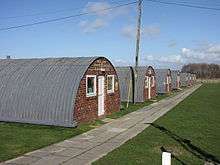Peter Norman Nissen

Peter Norman Nissen (August 6, 1871 – March 2, 1930) was a Canadian-American mining engineer and inventor. He held a number of patents for his inventions and developed the Nissen hut prefabricated shelter during World War I. [1] [2]
Early years
Peter Norman Nissen was born in the United States. His father, Georg Herman Nissen, had immigrated from Bergen, Norway during 1857. Georg Nissen was primarily a mining engineer who developed a Stamp mill used in crushing ore. The family, which included his wife Annie Lavinia Fitch and son Peter, travelled around the United States and Canada as he changed job sites.
Peter Nissen moved with his family to Canada in 1891. He resided in Halifax, Nova Scotia and later studied mining engineering at the Mining and Agriculture School of Queen's University in Kingston, Ontario. Nissen completed his studies without taking the final examination. It was at Queen’s University that he met his future wife, Louisa Mair Richmond, whom he married in 1900. [3]
World War I
In 1910 he moved to Witwatersrand, South Africa with his wife and daughter Betty and in 1913 he moved to Great Britain. Nissen worked there principally in the sale and distribution of the Nissen Stamp mill until he joined the British Expeditionary Force at the start of World War I. It was as a captain in the Western Front, that Nissen developed the Nissen hut during 1916. He rose to the rank of major with the 29th Company of the Royal Engineers. By the time the war ended, he had achieved the rank of lieutenant colonel and was awarded the Distinguished Service Order for his contribution to the war effort. [4]
Later years
In 1921 he purchased a house in Westerham in Kent where he lived until his death. He was naturalized in 1921 as a British subject. There was no separate and distinct status of Canadian citizenship at that time, and Canadians were British subjects. He earned little in royalties from his hut. His first wife, Louisa, died in July 1923. Peter Nissen then married Lauretta Maitland in 1924. They had two children. Peter and George Nissen. Peter died during 1930 and was buried at St Mary's churchyard in Westerham. [5]
Patents
- Ore stamp-mill. US 776414 A. Publication date Nov 29, 1904. Assigned to The Nissen Engineering Co.
- Ore-stamp-mill mortar. US 945135 A. Publication date Jan 4, 1910. Assigned to The Nissen Engineering Co.[6]
Awards
Nissen was awarded by Serbia in 1919, the Order of St. Sava, third class.[7]
References
- ↑ "Nissen hut". Norfolk Tank Museum. 20 Apr 2012. Retrieved August 12, 2015.
- ↑ "Nissen Huts". tenpoundpom.com. Retrieved August 13, 2015.
- ↑ Stanley Challenger Graham (20 Apr 2012). "The Nissen Hut And Its Inventor". Stanley's View at talktalk.net. Retrieved August 12, 2015.
- ↑ Fred McCosh (1997). Nissen of the Huts: A biography of Lt Col. Peter Nissen, DSO. B D Publishing. ISBN 0 9525799 1 X.
- ↑ "A Walk around the centre of Westerham". Westerham Town Partnership. Retrieved August 13, 2015.
- ↑ "The Nissen Engineering Co". Los Angeles Herald, Volume 32, Number 337. 3 September 1905. Retrieved August 12, 2015.
- ↑ The London Gazette Publication date:21 October 1919
Related reading
- Stephen Van Dulken (2002). "The Nissen Hut". Inventing the 20th century: 100 inventions that shaped the world. p. 44. ISBN 978-0-8147-8812-7.